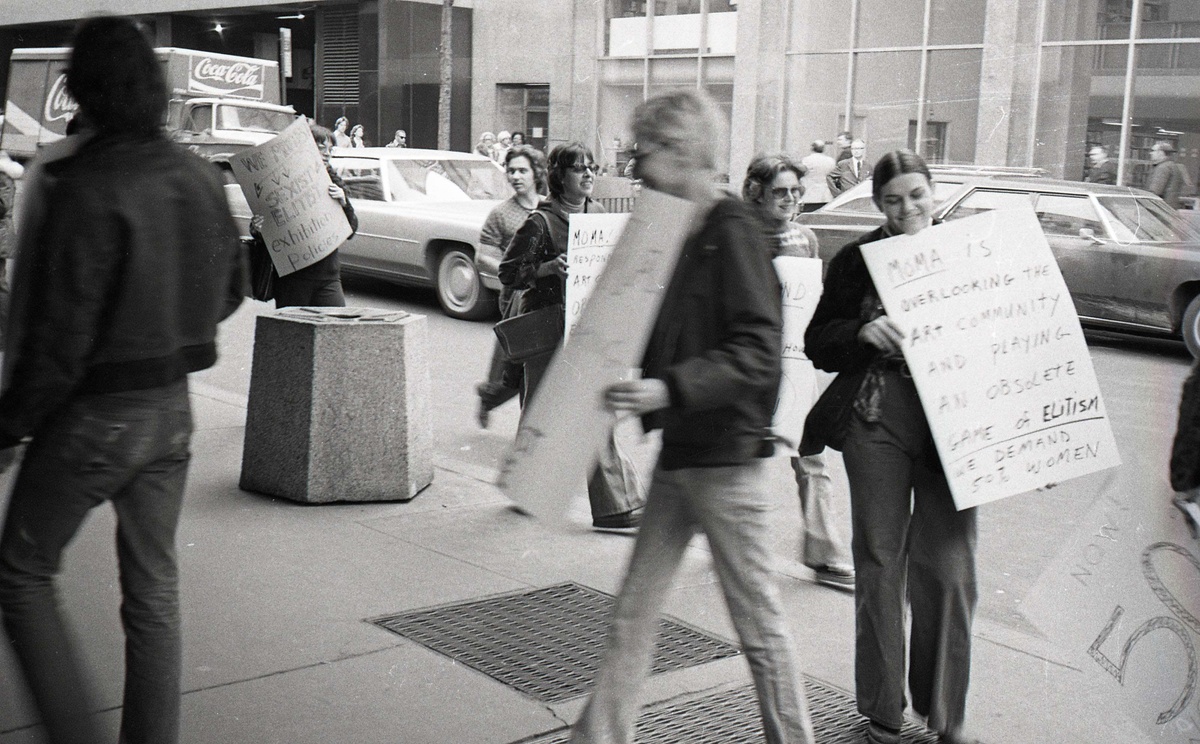Digital Exhibition
Roxana Fabius, Taylor Bluestine, Amber Esseiva, Christian Camacho-Light
A.I.R. Gallery: Chapter 4
Roxana Fabius, Taylor Bluestine, Amber Esseiva, Christian Camacho-Light
Oct 14, 2022
A.I.R. Gallery (Artists in Residence, Inc.) is a feminist, artist-run non-profit arts organization for women and non-binary artists located in Brooklyn, NY. Founded in 1972, A.I.R. continues to build upon its history, bridging art and activism by providing a space for artists across a spectrum of intersectional identities and cultural perspectives. The organization advocates for a multiplicity of voices in the arts while facilitating intergenerational dialogue and continuing investigations of feminism.
Activism
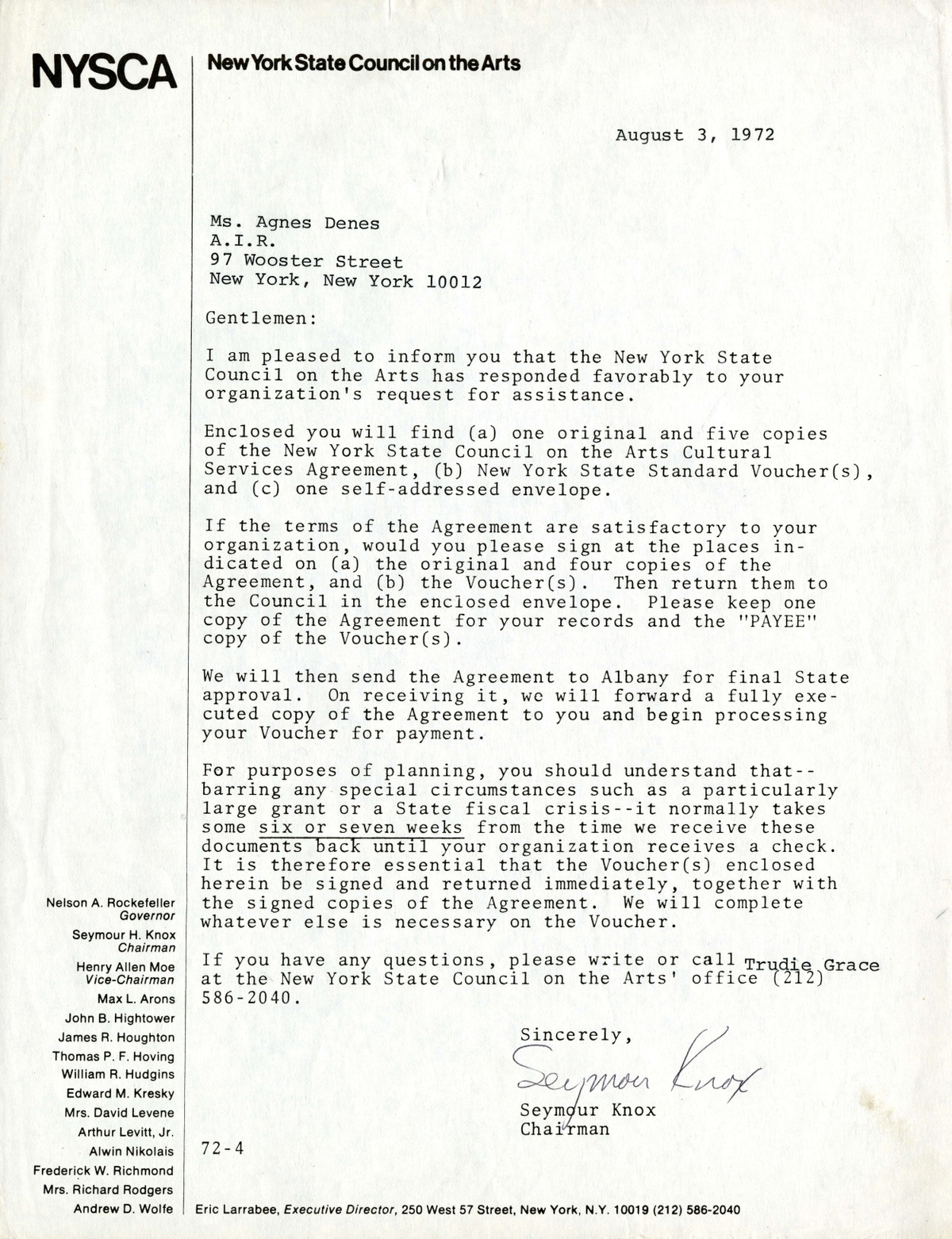
Digitized as part of a partnership between A.I.R. Gallery and The Feminist Institute, 2022. See record
On August 3, 1972, Chairman of the New York State Council on the Arts (NYSCA) Seymour Knox wrote a letter to inform A.I.R. that it had been approved for a grant from the council. The letter was mailed to Agnes Denes, a founding member of A.I.R. and pioneer of the land art movement, who helped bring ecological consciousness to contemporary art. Knox addressed A.I.R. as a group of “gentlemen,” showing a clear gender bias in NYSCA’s dealings with contemporary art institutions. The grant funded the initiation of the Monday Night Program series, which ran from 1972 to 1981. The programs included everything from general-audience panels on criticism, the market, and public art, to “slide raps” on women’s work, to helpful “how-to’s” (“Getting Your Work Out,” “Tax Night,” workshops on pottery, weaving, and “making things”).
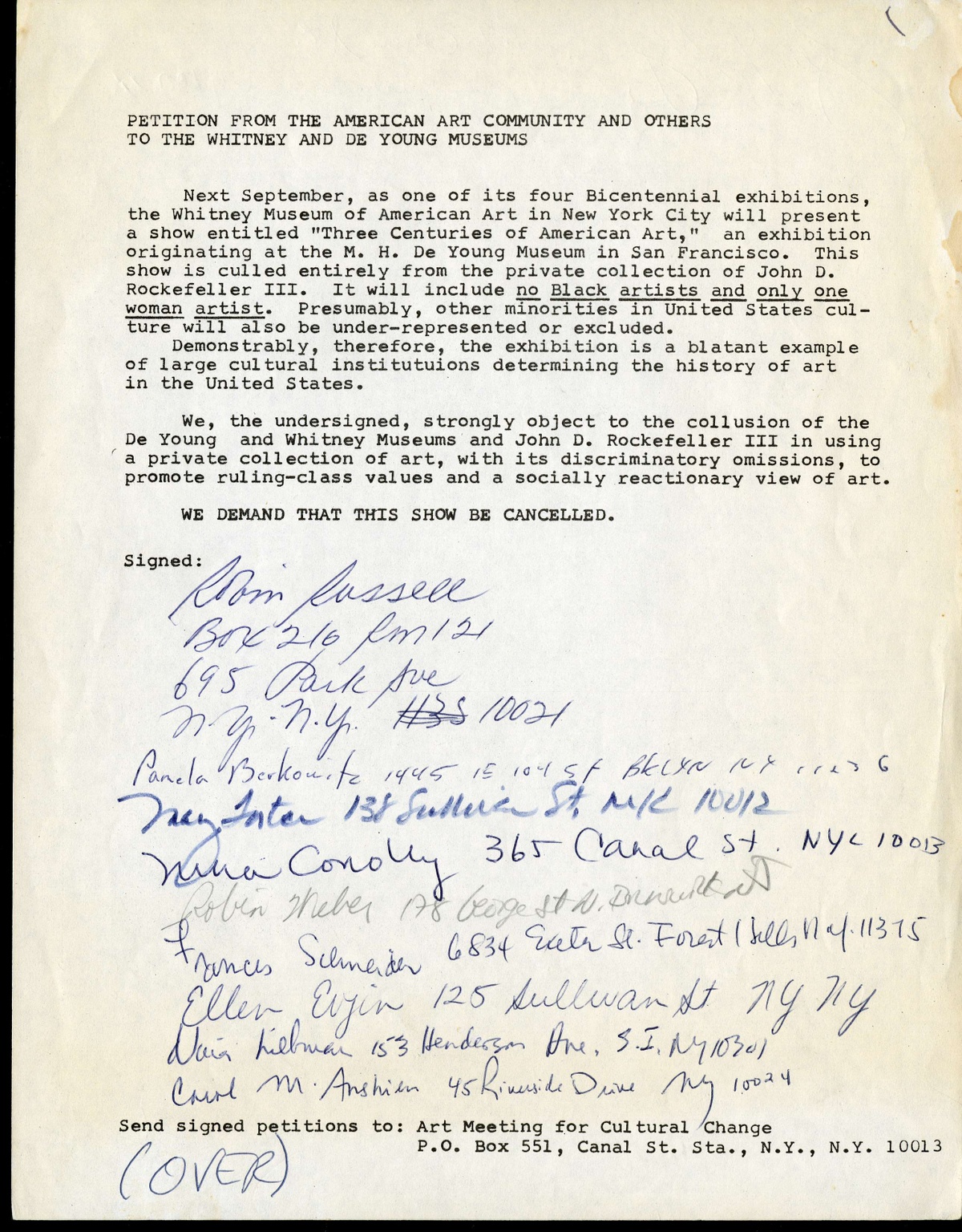
Digitized as part of a partnership between A.I.R. Gallery and The Feminist Institute, 2022. See record
In 1976, A.I.R. artists demanded, by way of a petition, that an exhibition at the Whitney Museum of American Art be canceled. The show, titled Three Centuries of American Art, was heavily opposed by the artists for its lack of inclusivity, as it was to showcase only one piece of art by a woman and none by people of color. The exhibition, which originated at the M.H. de Young Museum in San Francisco and had been scheduled to travel to New York, drew its works exclusively from John D. Rockefeller III’s collection. This petition, from the American Art Community and others, includes the signatures and addresses of supporters. The artists who mobilized and organized the protest against the exhibition ended up forming Artists Meeting for Cultural Change (AMCC), an activist group that pushed for the greater representation of diversity in the arts.
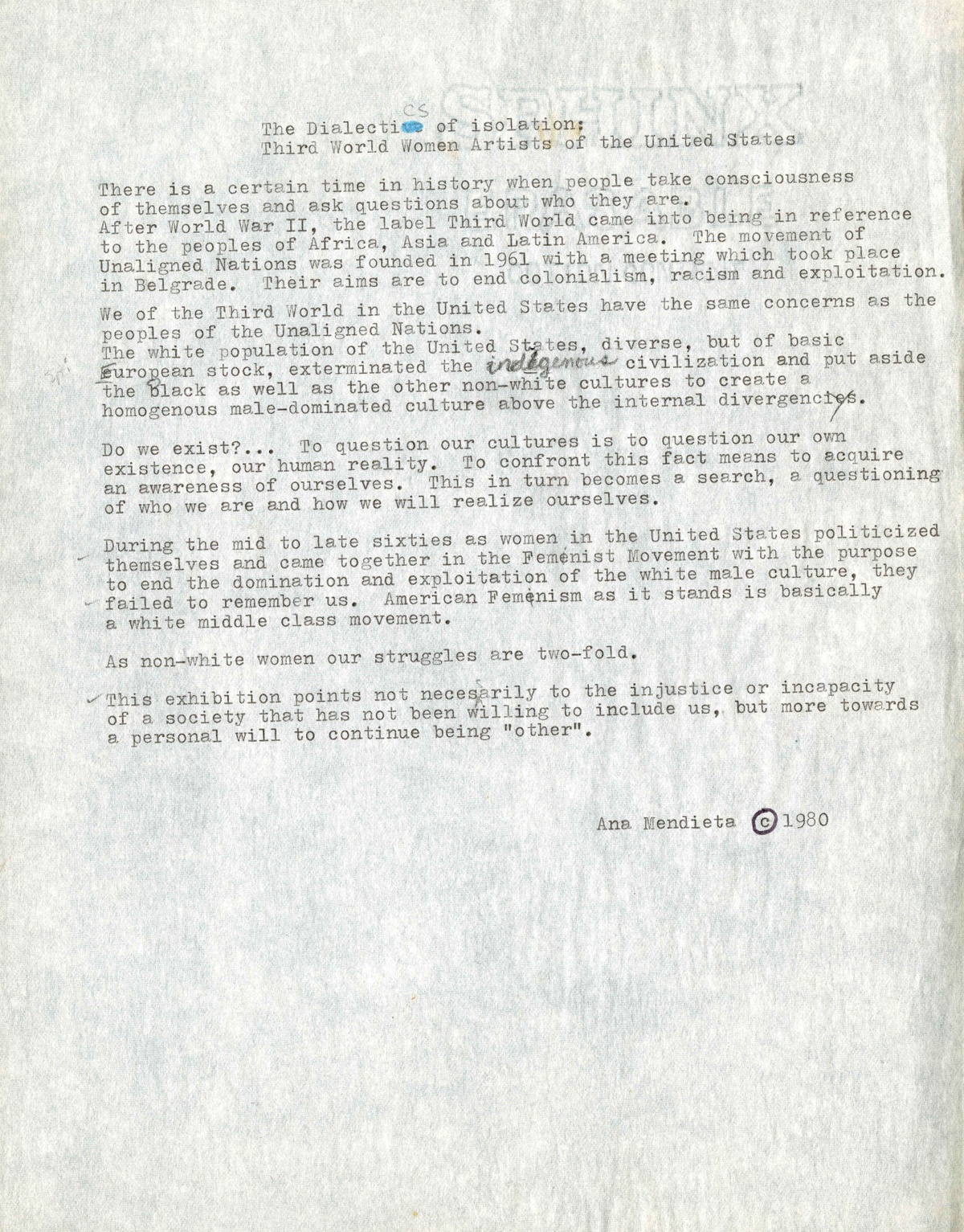
Digitized as part of a partnership between A.I.R. Gallery and The Feminist Institute, 2022. See record
In 1980, A.I.R. artists and members Kazuko Miyamoto and Ana Mendieta and artist Zarina Hashmi curated Dialectics of Isolation: An Exhibition of Third World Women Artists. The exhibition featured the work of Judith F. Baca, Beverly Buchanan, Janet Olivia Henry, Senga Nengudi, Lydia Okumura, Howardena Pindell, Selena Whitefeather, and Zarina, and sought to portray the disregard white feminists and American culture have toward women of color. Mendieta (1948–1985), a Cuban-American artist, wrote a powerful introduction for this exhibition in which she described the injustices of being both a woman and a person of color in the US. She highlighted the erasure of women of color in the American feminist movement that they helped to build and described “a personal will to continue being ‘other.’”
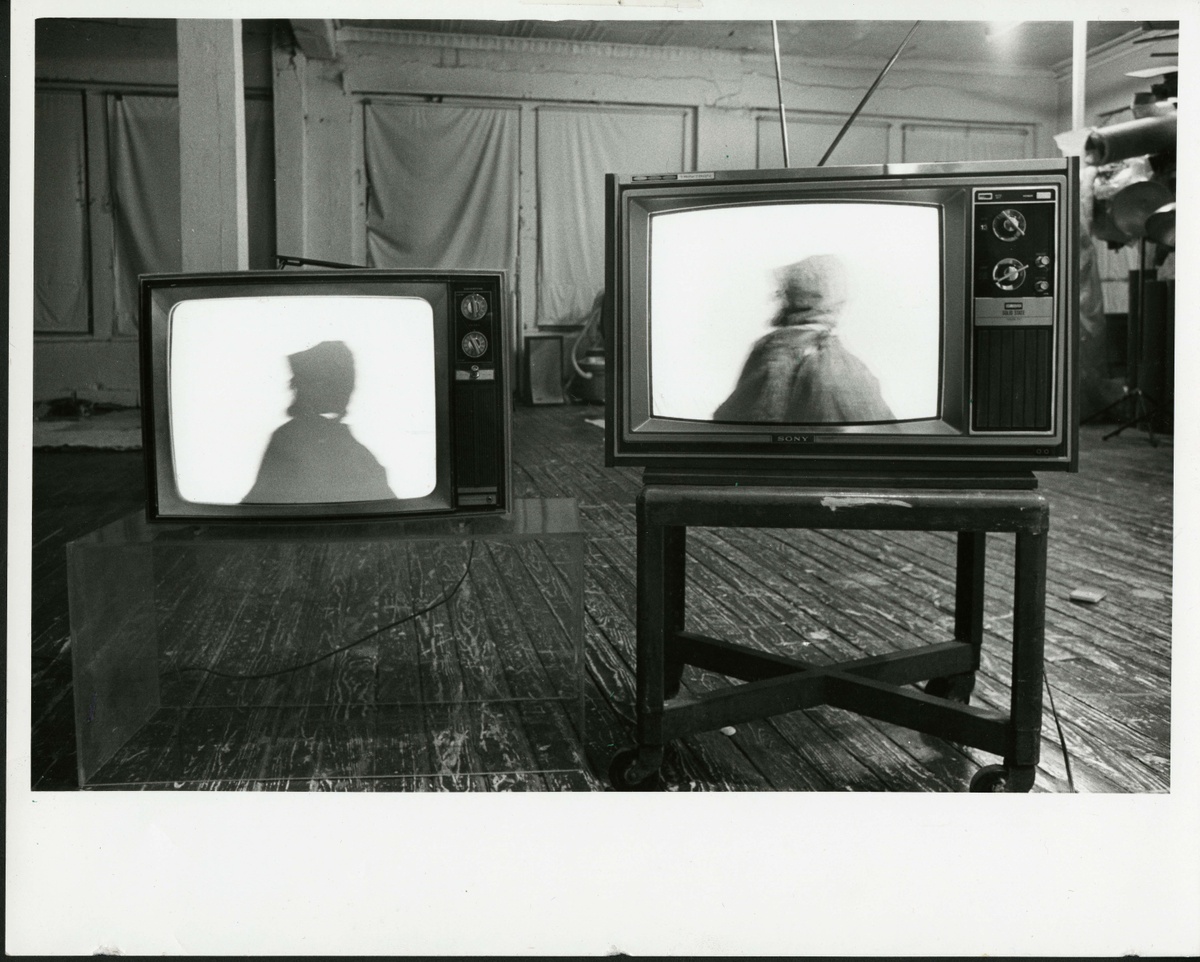
Digitized as part of a partnership between A.I.R. Gallery and The Feminist Institute, 2022. See record
Howardena Pindell (b. 1943), an American artist and founding A.I.R. member, first showed her 12-minute performance video Free, White and 21 in the exhibition Dialectics of Isolation: An Exhibition of Third World Women Artists in 1980. In this video piece, Pindell reflects upon her career, her relationship with white feminism, and her experience at A.I.R. specifically. This black-and-white photograph, which was featured in the exhibition catalog, captured Pindell’s silhouette as she retold stories about her personal experiences of racism and sexism. Throughout her career, Pindell has worked with gridded, serialized imagery to address social issues of homelessness, AIDS, war, genocide, sexism, xenophobia, and apartheid.
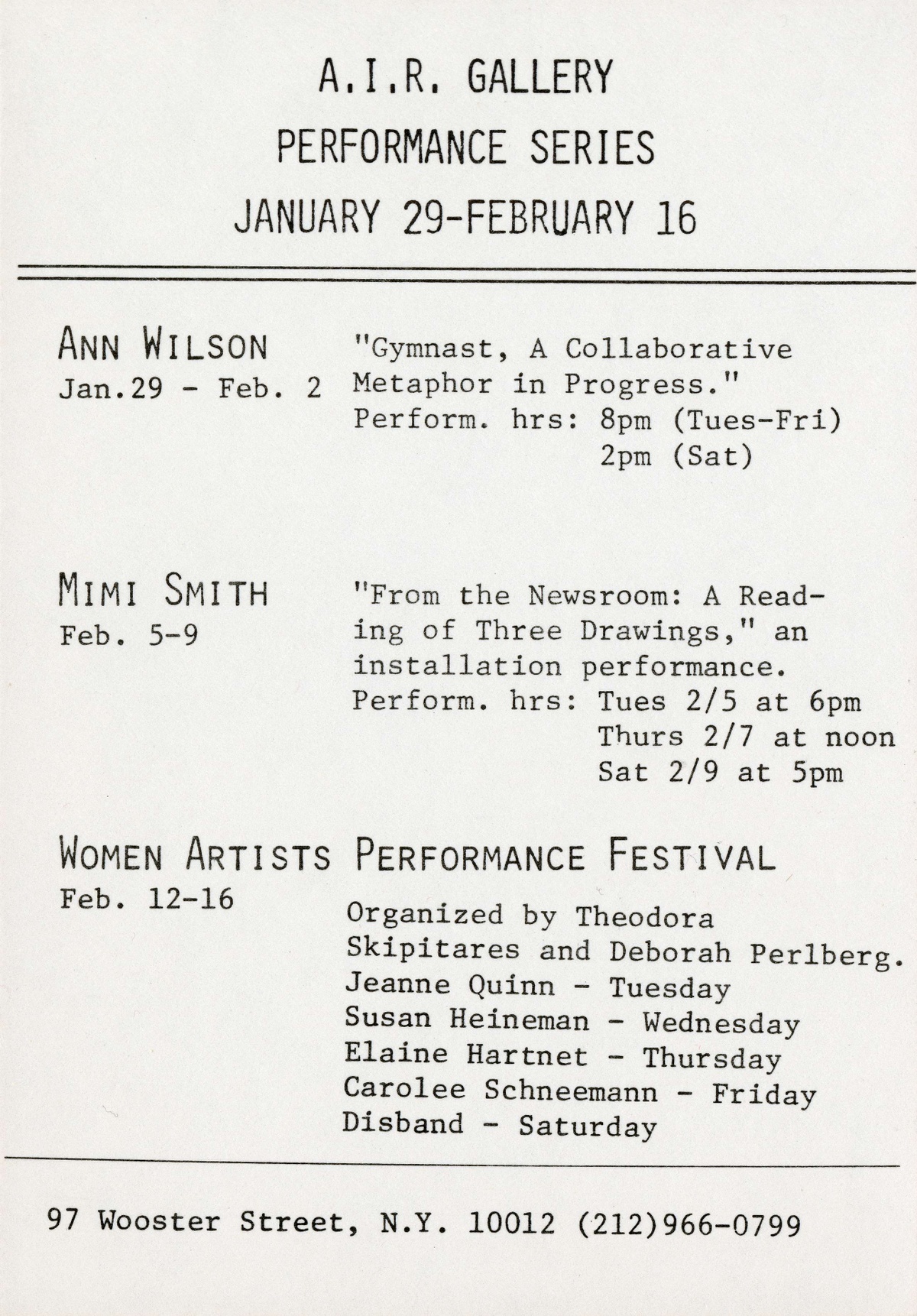
Digitized as part of a partnership between A.I.R. Gallery and The Feminist Institute, 2022. See record
To celebrate the diversity of womens’ artistic practices—which encompassed experimentation across and between media and disciplines—A.I.R. inaugurated its first women artist performance series in 1980. The series was later followed by a Women Artists Performance Festival, debuting performances by Jeanne Quinn, Susan Heineman, Elaine Hartnet, Carolee Schneemann, and the Disband, an alternative music band initiated by Martha Wilson.
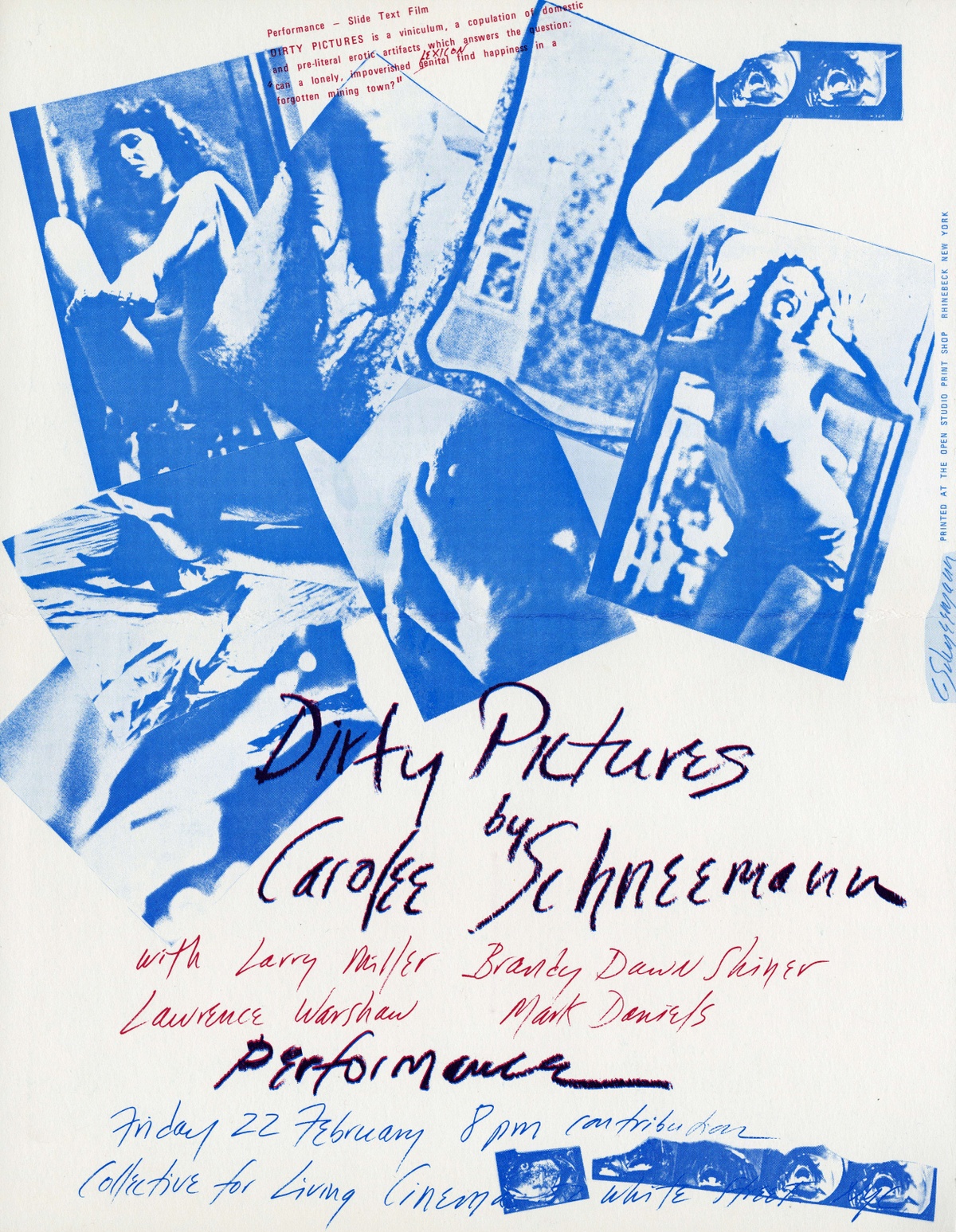
Digitized as part of a partnership between A.I.R. Gallery and The Feminist Institute, 2022. See record
Carolee Schneemann (1939–2019) was a pioneer of feminist performance art who abandoned the male-dominated abstract expressionist movement in favor of performance-based work that extended the discipline of painting into space. She sought to reclaim the nude female body from the male gaze and to challenge the taboo of nude performances in predominantly male gallery spaces. For this invitation to Dirty Pictures, a kinetic theater performance with slide text film that Schneeman held on February 22, 1980, at A.I.R., she collaged photos of female bodies in blue ink.
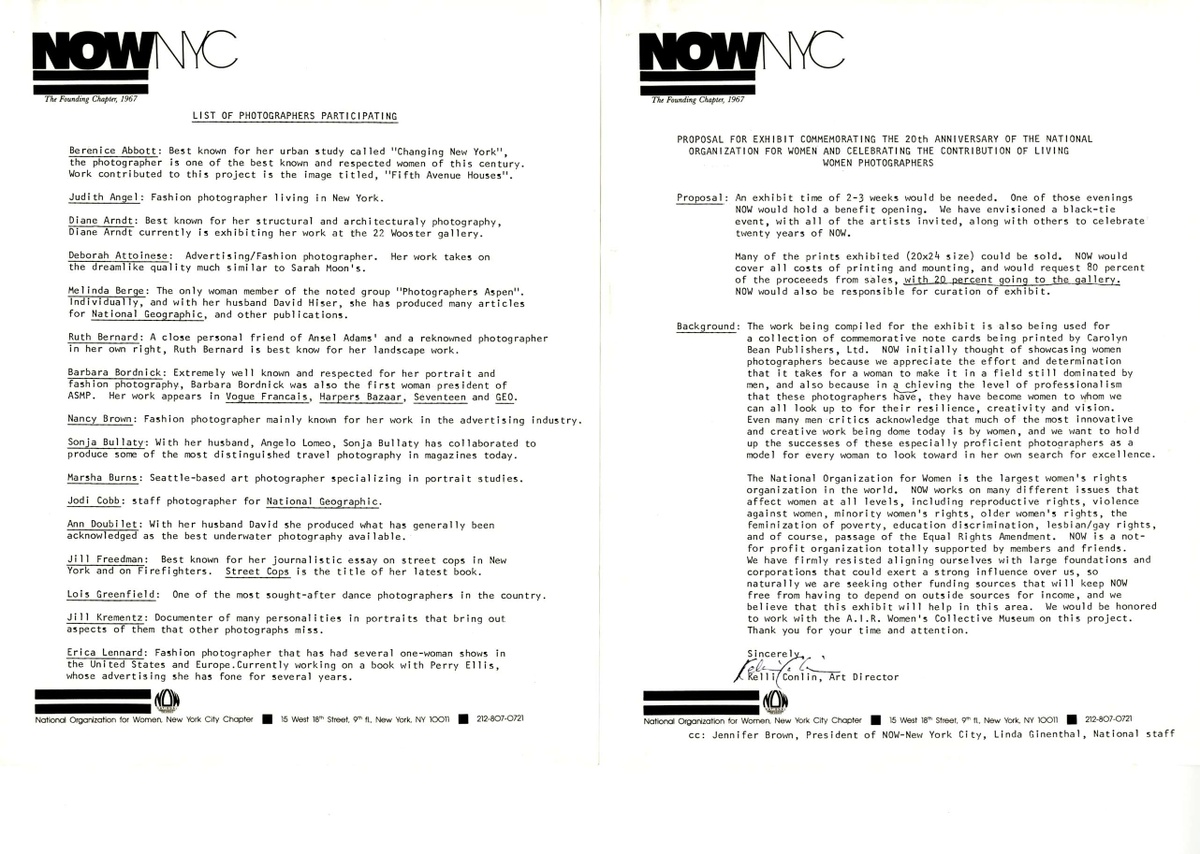
Digitized as part of a partnership between A.I.R. Gallery and The Feminist Institute, 2022. See record
This exhibition proposal, completed in collaboration with A.I.R., was for a photography show that would commemorate the twentieth anniversary of the National Organization for Women (NOW) and celebrate the contributions of a number of living women photographers, including Barbara Bordnick, Annie Leibovitz, Annie Griffiths, and Berenice Abbott. NOW, a feminist organization founded in 1966, focuses on issues related to women’s rights, LGTBQ rights, civil rights, and reproductive rights, and is the largest organization of feminist grassroots activists in the United States.

Digitized as part of a partnership between A.I.R. Gallery and The Feminist Institute, 2022. See record
In 1988, A.I.R. hosted the traveling exhibition Blue Angel: The Decline of the Sexual Stereotypes in Post-Feminist Sculpture, curated by Juli Carson and Howard McCalebb. The exhibition sought to contribute to the discussion of women’s issues within the arts in addition to the general dialogue of postmodernism, expanding the conventional notion of the feminist statement. It featured 12 women sculptors, including Faith Ringgold, Nancy Azara, and Hannah Wilke. Exhibited alongside the sculptures are photographs by Michael Shodahl depicting each artist in a context or environment that relates to her work.
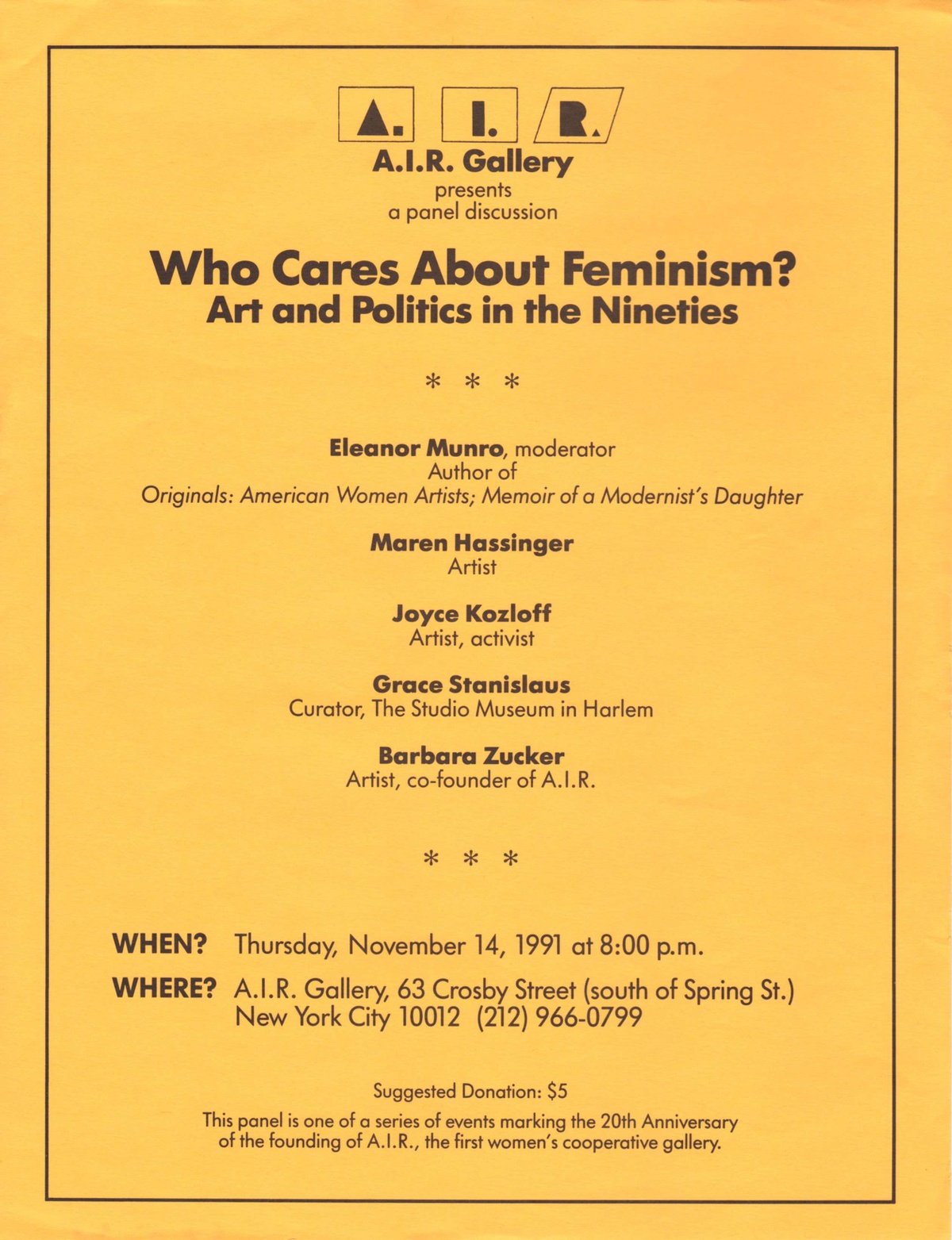
Digitized as part of a partnership between A.I.R. Gallery and The Feminist Institute, 2022. See record
In 1991, A.I.R. Gallery held a panel discussion at 63 Crosby Street called “Who Cares About Feminism? Art and Politics in the Nineties.” The event was part of A.I.R. Gallery’s twentieth Anniversary celebration. Eleanore Munro moderated the discussion, and the event featured guest speakers Maren Hassinger, Joyce Kozloff, Gace Stanislaus, and Barbara Zucker. A.I.R. members would also go on to participate anonymously in the artist-activist group Guerilla Girls, who focused on combating the art world’s pervading sexist and racist attitudes through gorilla masks and campaigns.
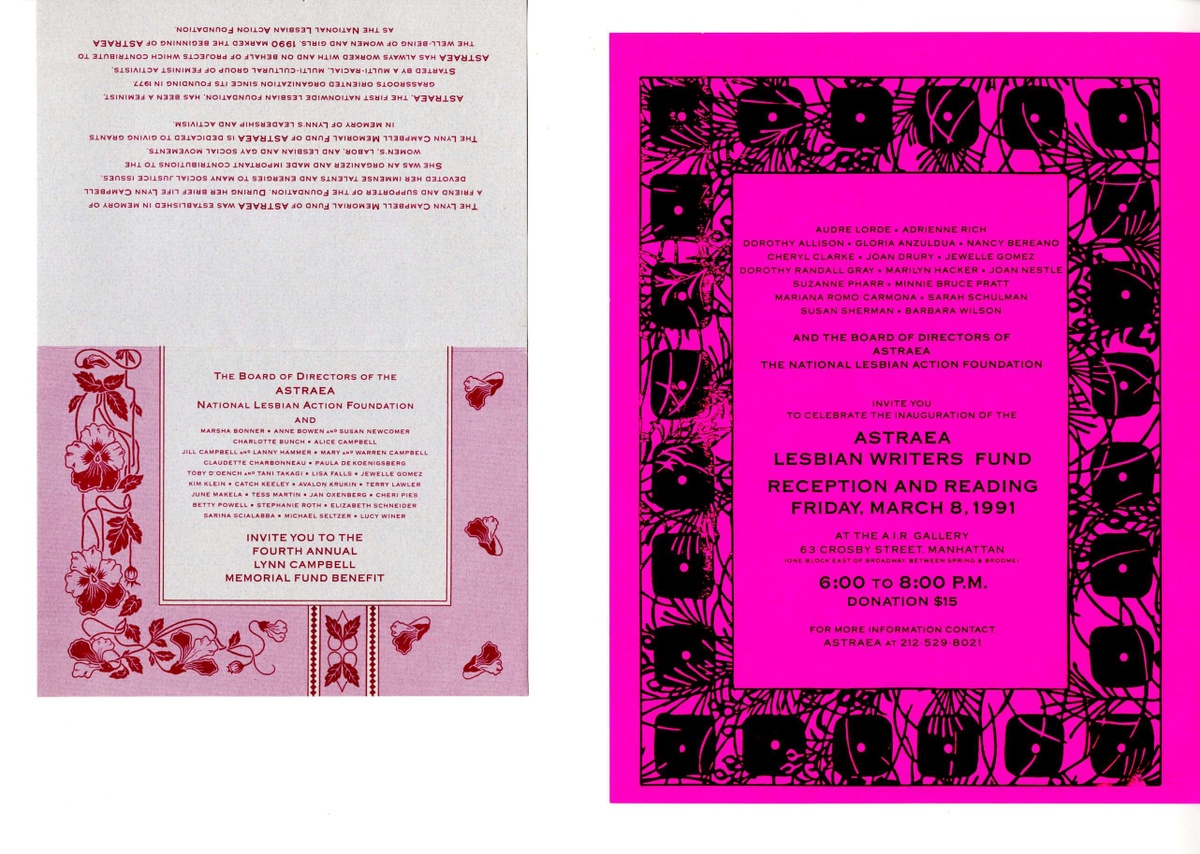
Digitized as part of a partnership between A.I.R. Gallery and The Feminist Institute, 2022. See record
The Astraea Lesbian Foundation for Justice is a charity focused on supporting LGBTQI human rights. Astraea launched the Lesbian Writers Fund in 1991, holding its first reception at A.I.R., and since then it has continued to fund grants that support emerging lesbian writers. This event highlights A.I.R.’s commitment to using its space to highlight and uplift other organizations.
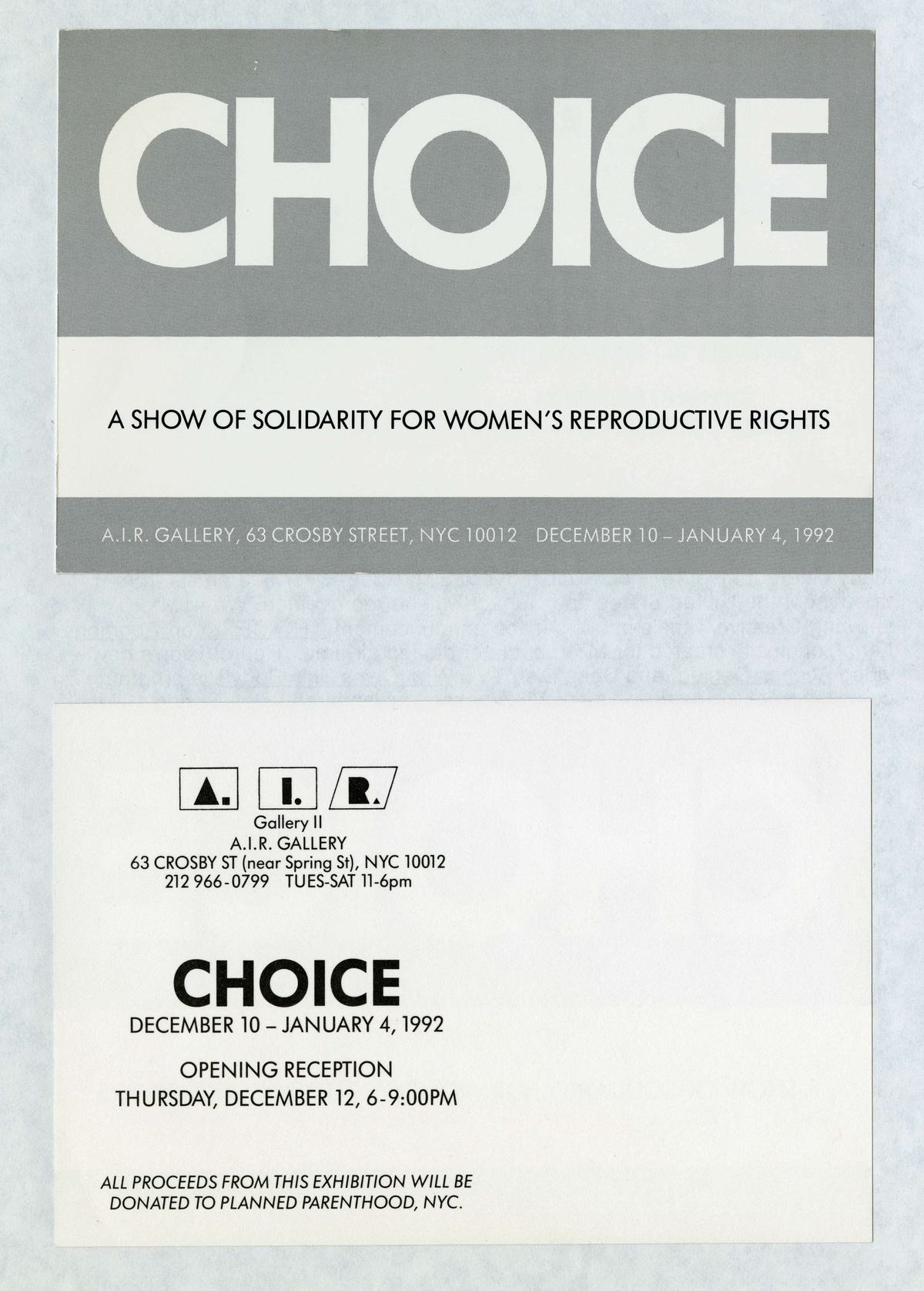
Digitized as part of a partnership between A.I.R. Gallery and The Feminist Institute, 2022. See record
Choice: A Show of Solidarity for Women’s Reproductive Rights was a 1992 exhibition at A.I.R. that featured over 750 small works touching on the issue of reproductive rights. The show was held at 63 Crosby Street, and all proceeds from the exhibition were donated to Planned Parenthood NYC, a provider of various women’s medical services, from breast-cancer screenings to tests for sexually transmitted diseases, and a critical point of access for abortion.
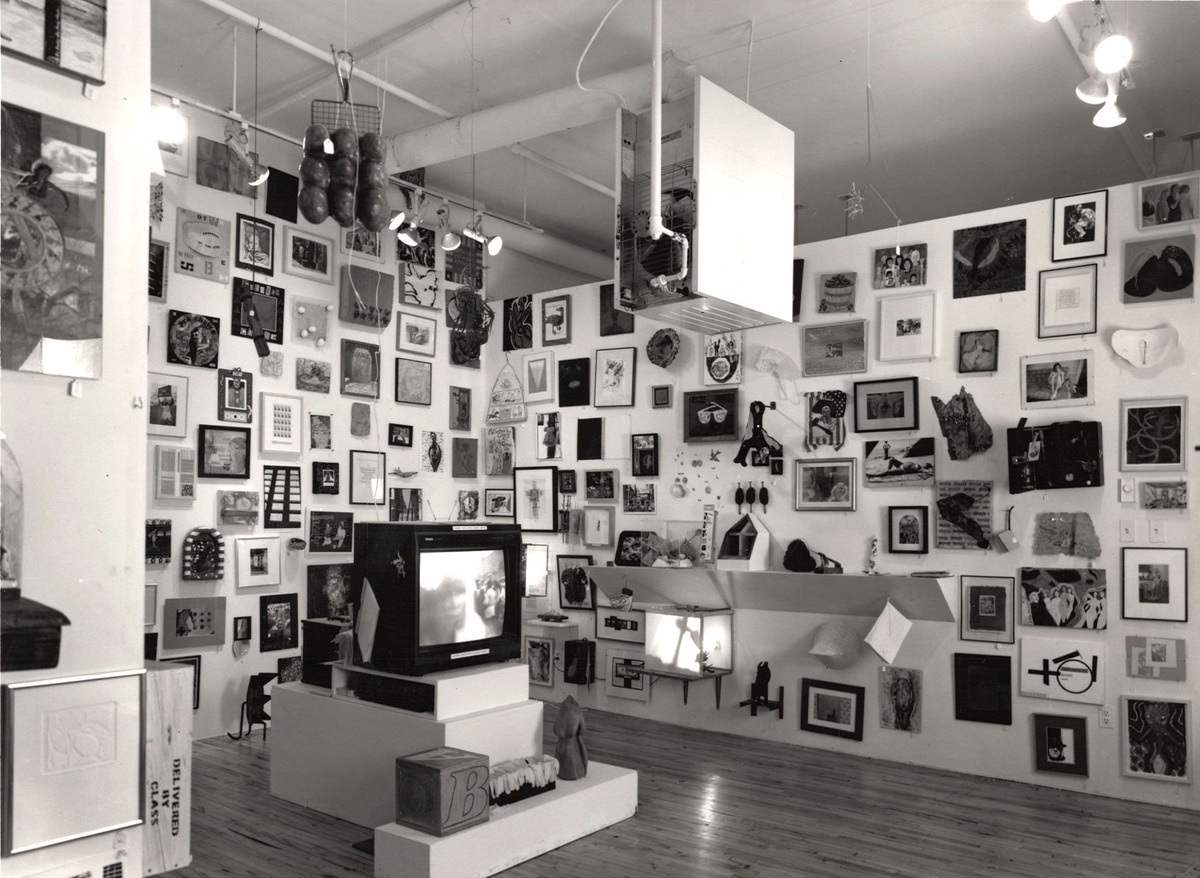
Courtesy of A.I.R. Gallery and Karen Bell.
The show featured art and objects on the wall, audiovisual content playing on a CRT TV, and other miscellaneous items.
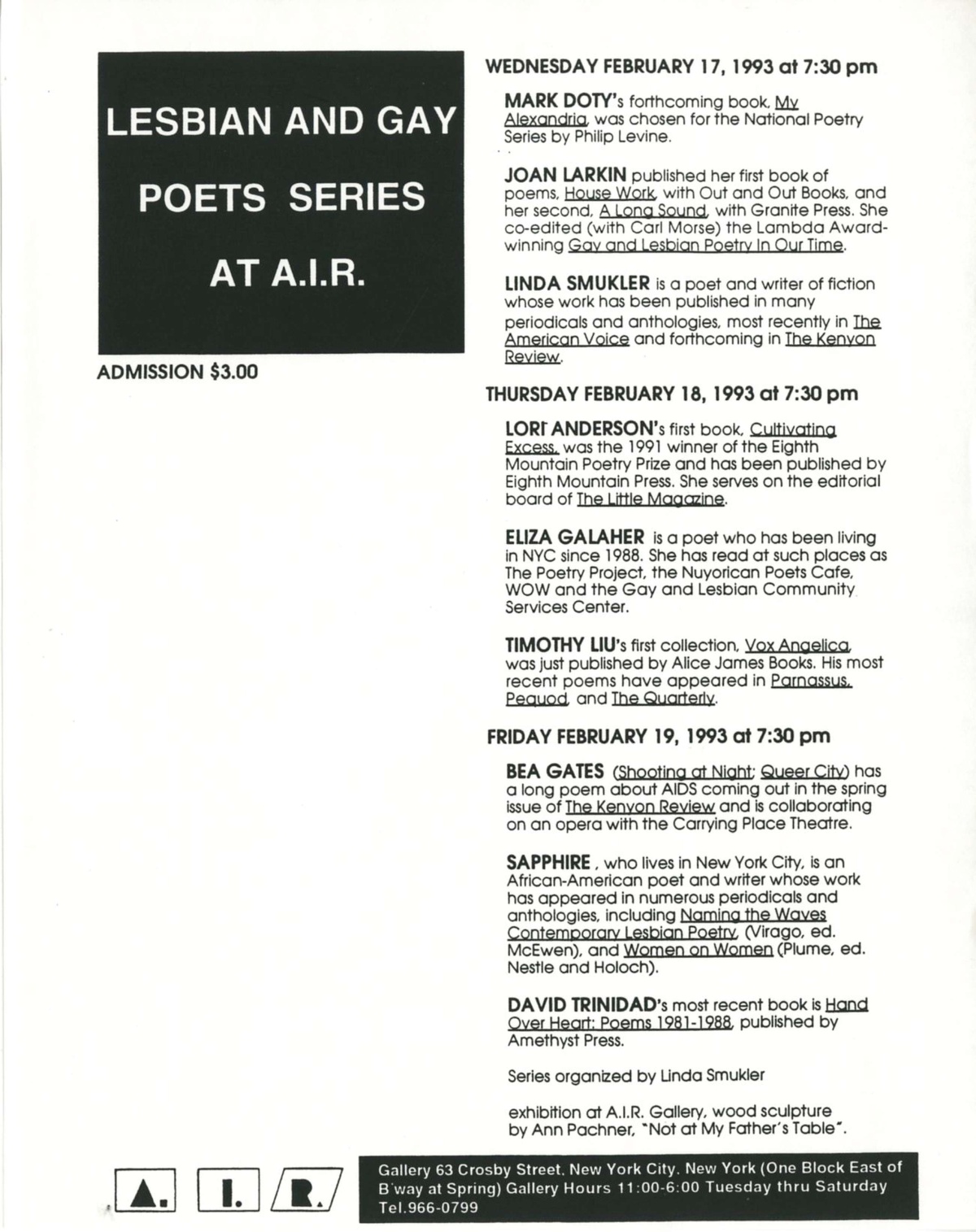
Digitized as part of a partnership between A.I.R. Gallery and The Feminist Institute, 2022. See record
The Lesbian and Gay Poets Series was a three-day event organized by Samuel Ace (Linda Smukler) and hosted by A.I.R. in 1993 that celebrated the work of nine poets from the local LGBTQ community: Lori Anderson, Sapphire, Bea Gates, Samuel Ace, Eliza Galaher, Joan Larkin, Mark Doty, Timothy Liu, and David Trinidad. The event series was partially the result of Ann Pachner’s desire to engage the gallery in more dialogue with the lesbian and gay community, and coincided with her solo exhibition of wood sculptures, Not at my Father’s Table.
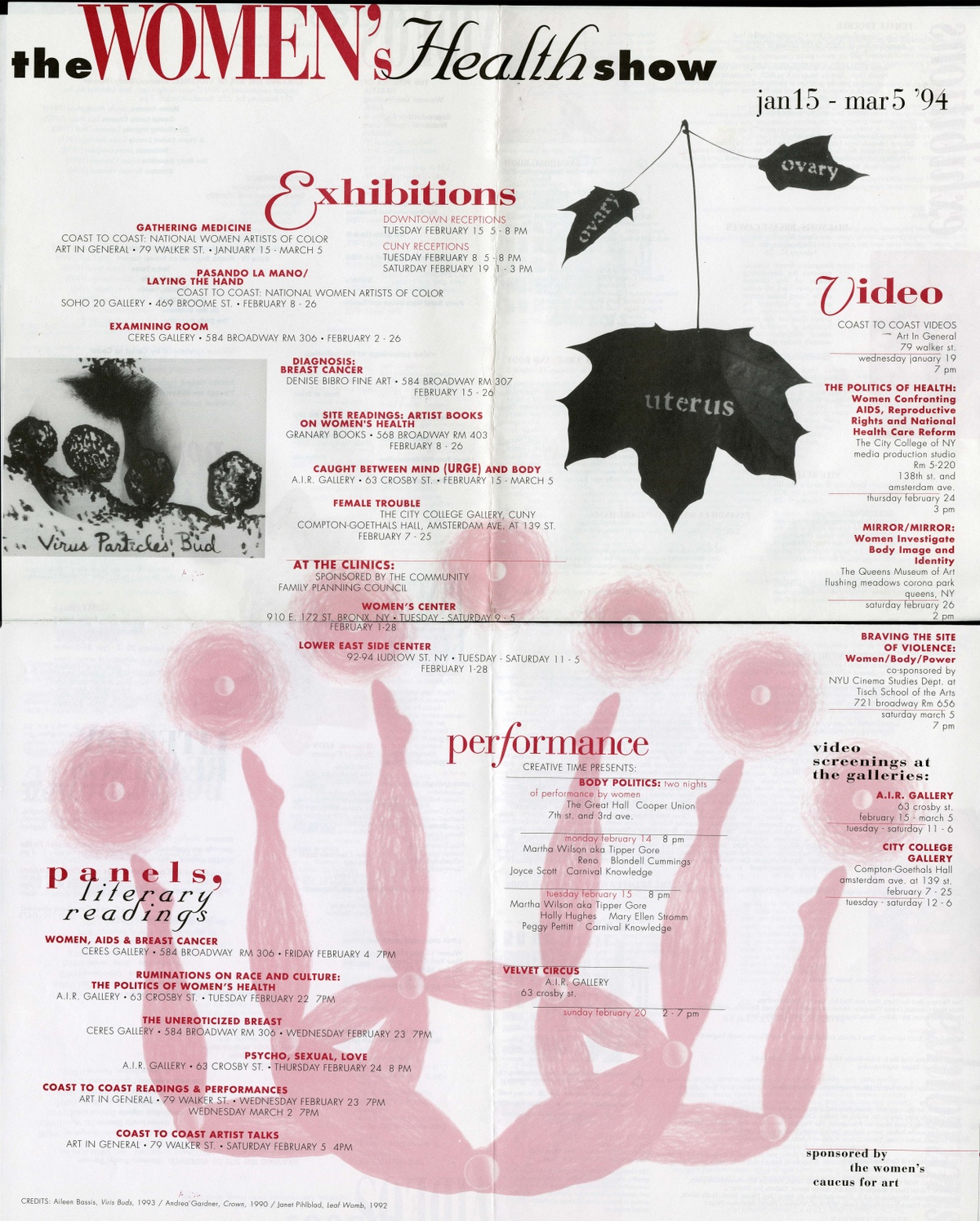
Digitized as part of a partnership between A.I.R. Gallery and The Feminist Institute, 2022. See record
Launched in collaboration with the Women’s Caucus for Art, Women’s Health Show was an exhibition held at various galleries throughout SoHo, including A.I.R. Gallery at 63 Crosby Street, in 1994, to expose the biases the medical industry held toward women. The exhibition included videos, performances, and panels of literary readings. This poster was designed with leaves and a lotus-like arrangement of legs with circles above them. In 2018, A.I.R. Gallery, SOHO20, and Triangle Arts Association, in collaboration with curator and writer Rachael Rakes, organized The Health Show II, a month-long contemporary reiteration that sought to continue the ideas and advocacy of the original project, while addressing a more inclusive group and respecting the politics of intersectionality.
Related items from the archive
Chapter 4: Full Text + Extended Exhibition Credits
Co-organizers:
Taylor Bluestine
Roxana Fabius
Editorial Development:
YiWen Wang
Nicole Kaack
Isha Tripathi
Erica Fedukovitch
Ada Jiang
Copy Editor:
Andrew Scheinman
Commissioned Writers (Chapter 4):
Amber Esseiva
Her essay and bio are available here.
Christian Camacho-Light
Their essay and bio are available here.
Special thanks to Fales Library at NYU Special Collections Center and NYU Special Collections Curator for the Arts and Humanities Nicholas Martin, Marie Williams Chant and Caroline Bracken at The Feminist Institute, Christian Camacho-Light, Daria Dorosh, Joan Snitzer, Susan Bee, and all the members of the A.I.R. community who helped make this project and the last 50 years possible.
